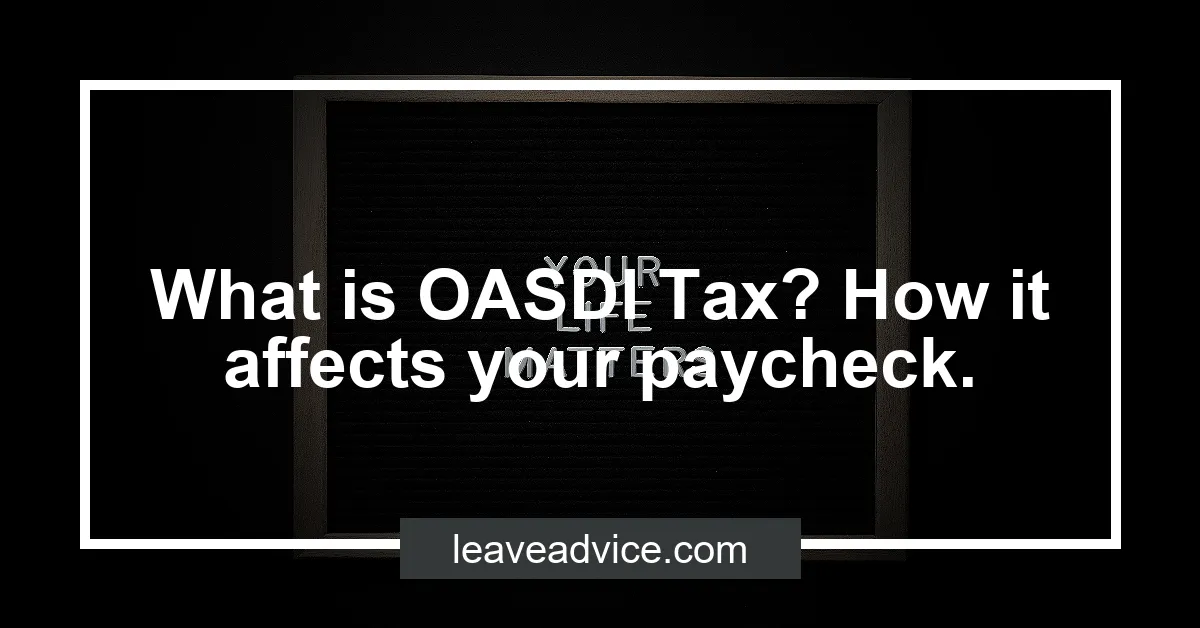What is OASDI Tax? How it affects your paycheck.
Have you ever taken a close look at your paycheck and wondered, “What is OASDI?” OASDI tax is a deduction that appears on your paycheck and is a critical source of income for retired and disabled individuals, as well as their dependents.
According to the Social Security Administration, the OASDI program offers monthly benefits to eligible recipients, including retired and disabled workers, their dependents, and the families of insured workers who have passed away. In this article, we’ll explore what OASDI tax is all about and how it can impact your financial situation.
Check out this Youtube video: “What is the OASDI Tax? OASDI Tax: 4 Most Important Points #short” to gain a better understanding of how the OASDI tax works and its impact on your finances.
What Is OASDI?
OASDI, or Old-Age, Survivors, and Disability Insurance, is a government program that provides monthly benefits to eligible retired and disabled workers, as well as their dependents and surviving relatives. The amount of benefits received is based on the worker’s Social Security contributions.
This program is primarily funded through payroll taxes and plays an important role in supporting individuals who rely on it for financial security.
What Is OASDI Tax?
OASDI tax is a payroll tax that helps fund Social Security benefits for retired, disabled, and surviving Americans. Both the employer and employee contribute 6.2% of the employee’s wages, up to a specific earnings limit set annually by the Social Security Administration.
OASDI tax is part of the Federal Insurance Contributions Act (FICA) and is an essential component of the US tax system.
How Does OASDI Tax Work?
OASDI tax, also known as Old-Age, Survivors, and Disability Insurance tax, is a government tax that is deducted from your income to fund the Social Security program. This tax is collected automatically from your paycheck, alongside the Medicare tax, as part of the Federal Insurance Contributions Act.
The percentage of OASDI tax that you pay is based on your income, up to a limit. In 2022, this limit is $142,800.
If you earn less than $142,800, you’ll pay 6.2% of your income in OASDI tax. If you earn more than $142,800, you won’t have to pay OASDI tax on the additional income.
Overall, OASDI tax is a crucial part of the Social Security program that provides support to retired, disabled, and widowed individuals.
Is OASDI Tax Mandatory?
Yes, OASDI tax is mandatory for most employees and employers. According to www.annuity.org, it is an American tax charged on the money earned to support the Social Security Program.
It is part of the Federal Insurance Contributions Act, which also includes Medicare, and is taken directly from the paycheck. Certain groups may be exempt from paying OASDI tax, such as some religious groups and certain government employees.
OASDI tax pays for the Old-Age, Survivors, and Disability Insurance (OASDI) program, which provides monthly benefits to qualified retired and disabled workers and their dependents and to survivors of insured workers. These benefits help ensure that individuals have a source of income in their retirement or in the event of a disability or death.
As an American taxpayer, you may already be familiar with the OASDI tax, which stands for Old-Age, Survivors and Disability Insurance.
Can I Be Exempt From OASDI Tax?
According to annuity.org, only certain religious organizations, individuals who earn less than $400 per year through self-employment, and foreign academics and researchers who aren’t U. S. Citizens or permanent residents are exempted from paying OASDI tax. However, it’s important to note that exemptions aren’t given out automatically.
How Can I Avoid Paying OASDI Tax?
According to Annuity.org, there are exemptions from paying OASDI tax, but they are not granted automatically. Certain religious organizations, self-employed individuals earning less than $400 annually, and foreign researchers and academics who are neither U. S. Citizens nor permanent residents are considered exempt groups under OASDI tax.
If you don’t qualify for an exemption, it may be possible to reduce the amount of OASDI tax you owe by contributing to a tax-deferred retirement account such as a 401(k) or IRA. Participating in deferred compensation plans and working for an employer who is not subject to OASDI tax may also offer alternative solutions to avoid paying OASDI tax.
Conclusion
OASDI stands for Old Age, Survivors, and Disability Insurance. It serves as a social insurance program for approximately 90% of the workforce in the United States, including both employees and self-employed individuals.
Regular contributions are required from working individuals to secure their future with monthly benefits to support them after retirement. Understanding how OASDI works is crucial for managing personal finances and maximizing retirement savings.
References
- Old-Age, Survivors, and Disability Insurance (OASDI)
- Social Security and Medicare Taxes
- Old-Age, Survivors, and Disability Insurance (OASDI) Tax

